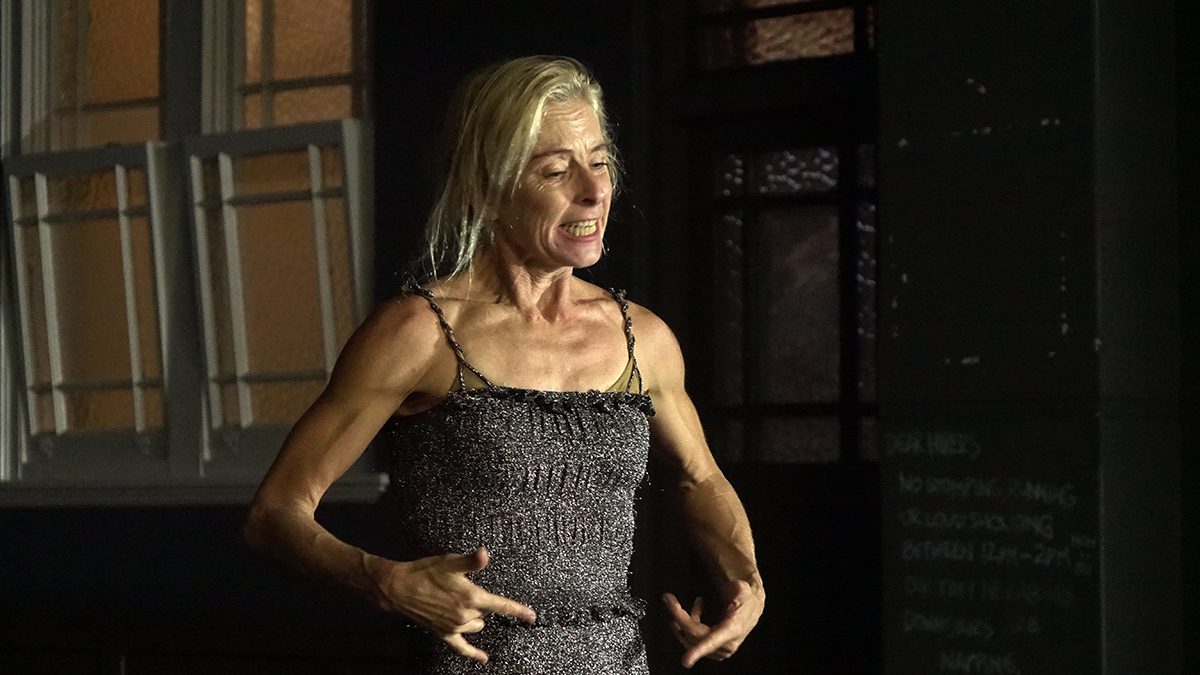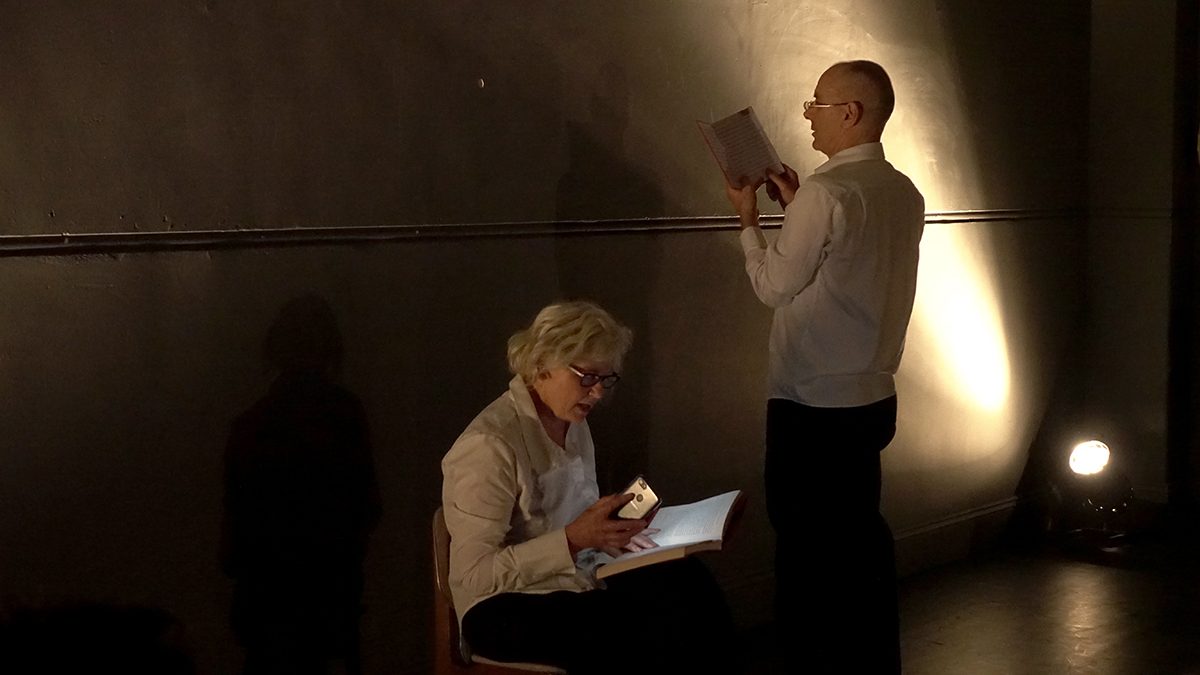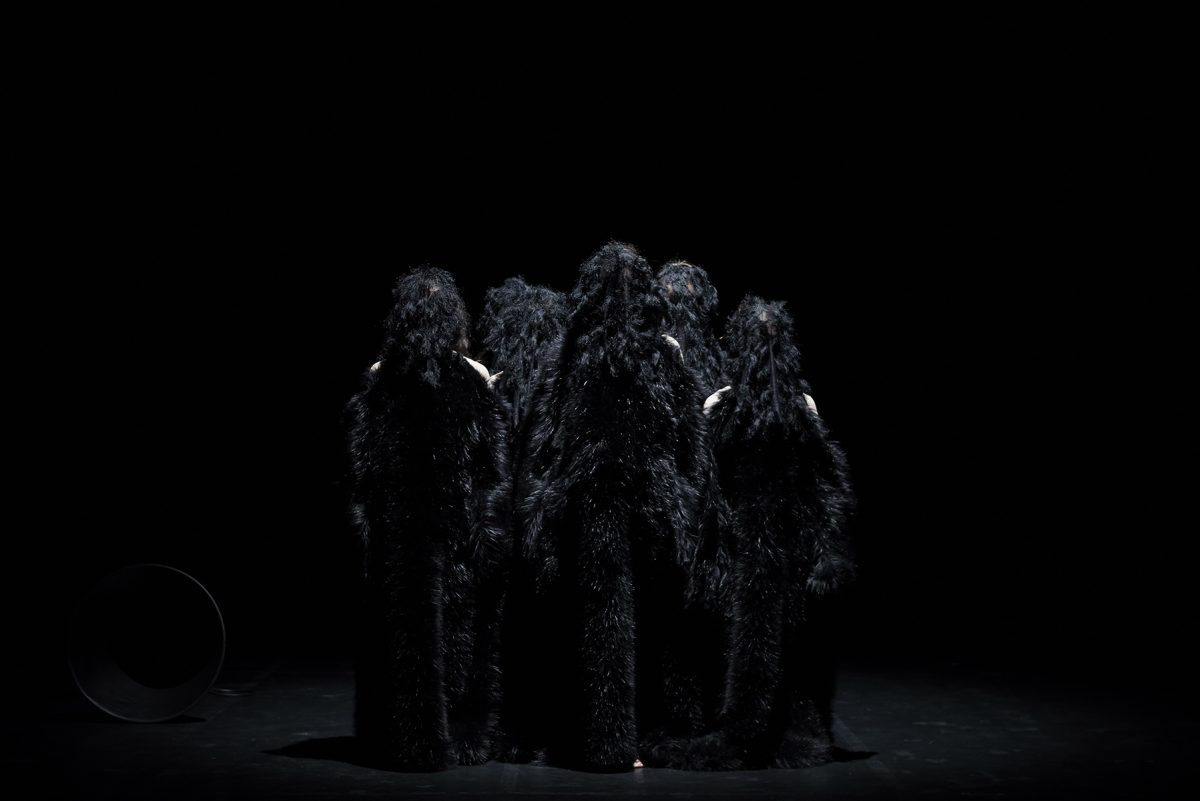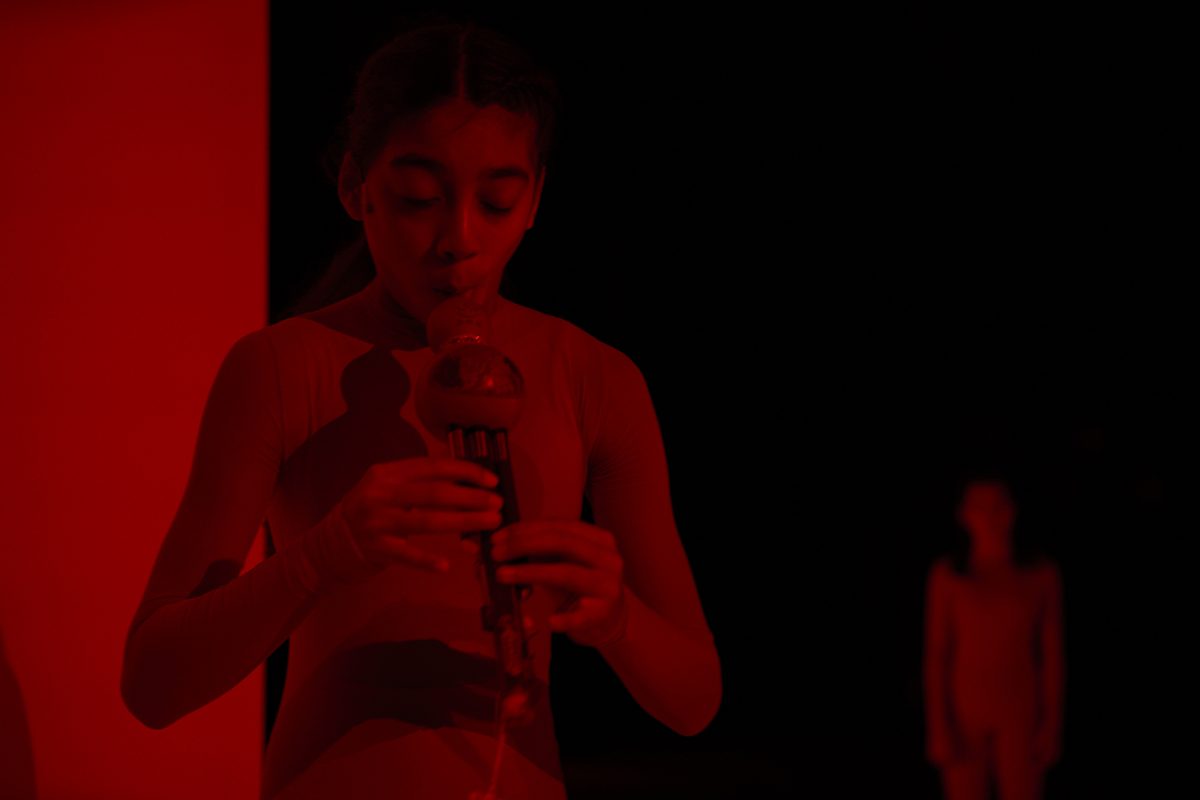May 2018
In three gripping performances artists embodied strangely mutating personae, intriguing their audience in the intimate Readymade Works studio in Sydney’s inner city Ultimo. Curator Julie-Anne Long (and Co-director with Sam Chester of the space) programmed highly experienced artists, feeling, as many of us have, she’d been deprived of seeing them in performance of late: Martin del Amo and Anton, Kathy Cogill, and Nikki Heywood and Tony Osborne (read about the artists and their extensive careers here) .
Anton, performing a segment from ARENA, a collaboration-in-progress with choreographer Martin del Amo, conjures a series of disparate characters, at first largely verbally and then by building distinctive bodies with specific trajectories, each returned to in a whirlwind of exacting movement — including a wild horse ride. The next stage in the work’s evolution, said del Amo in his introduction, will unfold startling connections between the characters. In the meantime, Anton delivers superb comic timing and deft characterisations while del Amo’s shaping of the idiosyncratic movement recalls his own solos in which quite lateral dance springs out of walking. I long to see the completed work.
In the delightfully perplexing The Levitation Act, Kathy Cogill traverses a variety of states of being, first quivering and glittering, folding deep down into herself, seemingly earth-bound, and subsequently manifesting as an agitated, declamatory French speaker, and then a mysterious trench-coated figure unloading a swathe of material and small objects. Somewhere in the mix is a lyrical passage of Strine and finally a brief sinuous duet in which, on her back, Cogill lifts her willowy daughter Clara Louw with elegant ease. It’s as if having progressed from the inability to leave the ground in the piece’s opening Cogill is now lovingly enabling the girl’s dancerly levitation. If fragmentary, the work has a kind of cogency wrought, like Anton’s, by charisma and felicitous movement.
In the engagingly enigmatic Sound & Its Double, “a spoken sound dance duet” performed in traverse, a Beckettian Nikki Heywood and Tony Osborne gather up and select from piles of seemingly identical books in bright red covers. The couple, close to but facing away from each other, angle the books as they bend towards limited light, muttering urgently and incoherently from the pages with a seemingly incidental musicality. When seated opposite each other, the books gradually set aside, it’s as if whatever was sought in the couple’s mouthings has not been found and a danced and raw vocalised hostility ensues, erupting against the self, against the other. Perhaps it’s cathartic: the couple find brighter light with which to read and, though seemingly oblivious to the other, their words make limited sense, the lyrical duet of alternations and overlaps suggesting a state of being at once together and apart. With further development Sound & Its Double could make a welcome return.
This showing was the first Happy Hour of three this year in a Sydney desperate for independent dance opportunities, for artists and audiences alike. The impressive list of artists who presented last year includes Timothy Ohl, Benjamin Hancock, Rosie Dennis, Raghav Handa, Sara Black, Lucky Lartey, Vicki Van Hout and Matt Cornell, and Heidrun Löhr and Hans Bildstein. Happy Hour is an admirable venture, bolstering a challenged Sydney dance ecology, remunerating artists and welcoming audiences with affordable ticket prices and access to artists. There should be more of it.
–
Readymade Works, Happy Hour, curator Julie-Anne Long, artists Martin del Amo & Anton, Kathy Cogill, and Nikki Heywood & Tony Osborne; Readymade Works, Sydney, 21, 22 April
Top image credit: Anton, ARENA, Happy Hour, photo Martin Fox
An ironically irresistible Hugo Weaving stars in Kip Williams’ thrillingly propulsive, politically gripping production for the STC of Bertolt Brecht’s The Resistible Rise of Arturo Ui, an unnervingly funny, relentlessly incisive parable of a thug-cum-demagogue rising to absolute power. He achieves it with the complicity of a corrupt politician in an all too familiar “infrastructure government” in league with a green grocery cartel. They quickly lose control of their gangster agent of change (whose initial goal is control of the vegetable market), then the courts, the press and ultimately the democracy they have hitherto expertly manipulated.
Though casually evoking 1930s Chicago and the gangster movies that inspired Brecht, director Kip Williams and translator Tom Wright infuse the production with a sense of our own troubled times via an artfully choreographed interplay of stage performance and live video feed with drolly deft deployment of the clichéd and distorting language of Australian and international politics and economics. The effect is to render contiguous the 30s rise of fascism and the current illiberal push to the right in modern democracies. Past and present become chillingly inseparable.
This world (designer Robert Cousins) is realised within a capacious studio with open dressing and green room spaces to either side and a huge upstage screen fed by a busy camera team working initially in movie-making mode and subsequently, as politics turns overtly criminal, delivering with television news urgency, intrusive vérité shooting and propagandistic pomposity. It’s not a simple trajectory: in a funeral scene late in the work there’s a highly effective return to an intimate cinematic vision, at once compelling but perhaps also mockingly arthouse.
Dressed and masked in black, the camera crew moves about unobtrusively, the numerous set-ups with actors seamlessly realised and the tracking trajectories marvellously patterned so that Kip Williams’ direction and Justine Kerrigan’s cinematography is realised as a swirling dance of cameras and actors. The director’s well-known choreographic-cum-cinematic facility is frequently evident, for example when Ui threatens the politician Dogsborough (Peter Carroll). The latter is seated downstage, back to us, facing Ui who delivers his intimidating spiel moving on and about an axis between his victim and the screen on which we see Dogsborough writ large in anxious profile. It’s a perfect fusion of stage and screen, heightened by Weaving’s cajoling ‘dance,’ exploiting oscillation between safe distance and threatening proximity. As ever, the actor moves with great verve, from an initial pugnacious, prowling swagger to the elegant, confident stride of the demagogue. When one of his gang earlier dares to suggest how he might present himself, Ui retorts, “What the hell is ‘natural’?” Unfortunately for his victims, Ui is, in another sense, a natural, and a quick learner.
True to Brecht’s wishes, the makers admirably avoid the literalising of Ui, whether as Hitler or any other demagogue, such as Donald Trump. There is however an hilarious lesson in Hitler-ish posturing — desultorily taught by a campy failed actor (Mitchell Butel) — and a brilliant one-off sight gag involving Ui toying with but dismissing the fascist leader’s moustache and hair style. Weaving’s Ui is utterly his own man, one with limited intelligence but blessed with tunnel vision and escalating narcissistic self-belief, incanting a narrative of heroic emergence melded with paranoia. This is realised brilliantly in Brecht’s echoing of Shakespeare’s Richard III in a confrontation between Ui and Betty Dullfeet (Anita Hegh), the combative wife of the newspaper publisher Ui has had murdered.
As rain falls steadily on the funeral gathering, Ui delivers a seemingly sincere self-account, impassioned and highly convincing, replete with cosmic metaphors, bewildering an angry but vulnerable woman suddenly confronted with the unexpected. As the staging reveals the scope of the gloomy, black umbrella-ed funeral, the screen close-ups of Ui and Dullfeet provide a cinematic intensity, yielding one of the few moments of heightened realism in the production if shot with a wry arthouse verve. Weaving invests all his considerable craft in the scene, the closest we get to empathising with Ui, momentarily understanding the depth of his self-belief, however fantastical, and in himself as a performer. When we next see Ui, he is a fully realised, coolly intimidating demagogue, terrorising a vast (cinematically multiplied) public into voting for him.
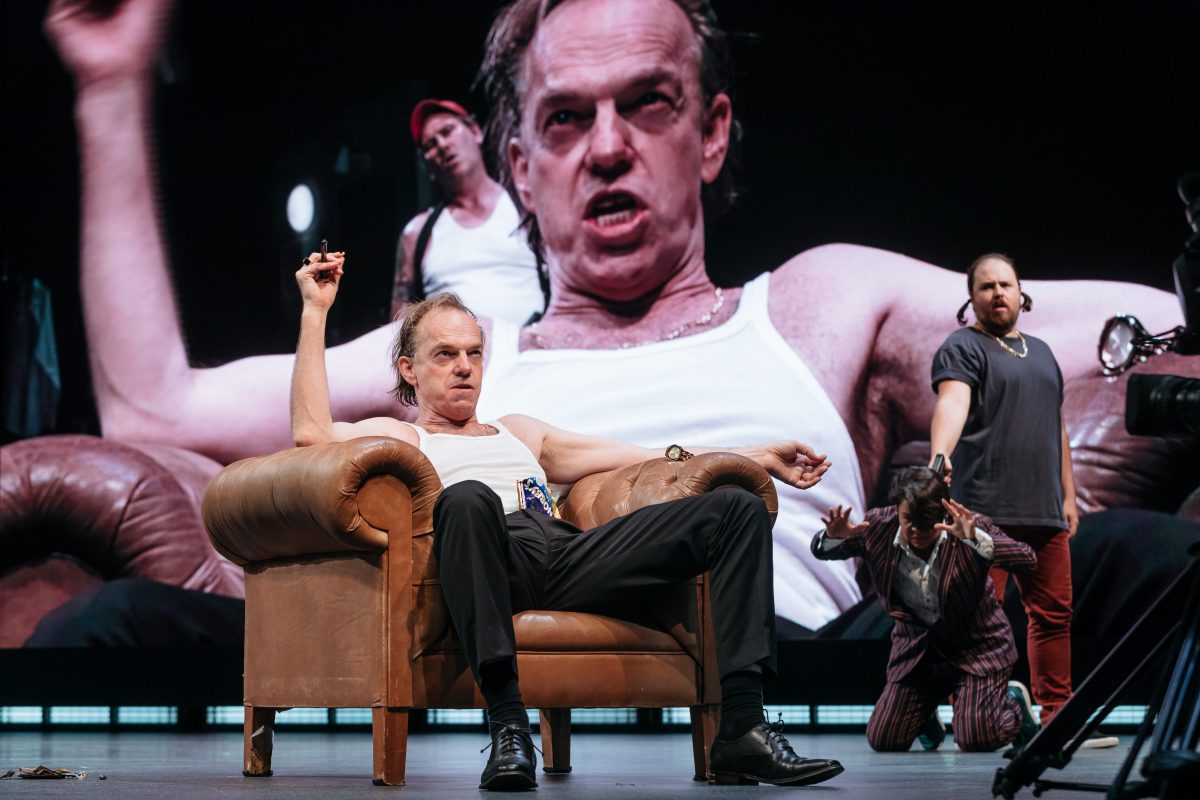
Colin Moody, Hugo Weaving (background), Hugo Weaving, Ursula Yovich and Brent Hill (foreground), The Resistable Rise of Arturo Ui, Sydney Theatre Company, photo © Daniel Boud
With Brecht’s hyperbolic text and a production excelling at the playwright’s notion of distanciation, the funeral scene is a thrilling disruption, as are the scenes in which Peter Carroll’s Dogsborough is granted a palpably intimate presence. In part driven to corruption by the need to support a son with a disability and by Ui’s thinly veiled threats directed at the child, the politician becomes increasingly guilt-ridden, creating a moral counterpoint to Ui’s career, strongly felt in a scene in which Dogsborough quietly ponders his crime and Ui’s rise while face to face with himself in a dressing room mirror, one of a number of mirror images in the production that query the nature of performance of the self.
Another scene tellingly focused on the face has Ui’s gang members spread about the stage bitterly challenging each other while a camera operator peers up between the boss’s knees. Weaving is slouched in a lounge chair, Ui’s usually hyper-animated features shut down, his heavy brow creased with introspection as he nibbles from a packet of Nobby’s Nuts. The close-up stillness exudes danger as much as comedy, indicative of a new stage in Ui’s rise, a contemplative prelude to murderously taking firm control of his own immediate realm.
Williams’ production busily fills the stage with evolving political ferment, first evident in a Senate-type enquiry scene (with Anita Hegh doing a Michaelia Cash microphone grab) overseen by Arturo Ui (think President Donald Trump’s destructive appointment of Scott Pruitt as Environmental Protection Agency Administrator). Later, a courtroom trial turns to farce as Ui’s thugs take control. Staged as a series of brief scenes punctuated with a repeated dance of pulsing spotlights as the performers reconfigure, it’s rich in comic detail, including Peter Carroll as an enthusiastic female courtroom stenographer rendered deliriously helpless as characters and cameras swirl about her.
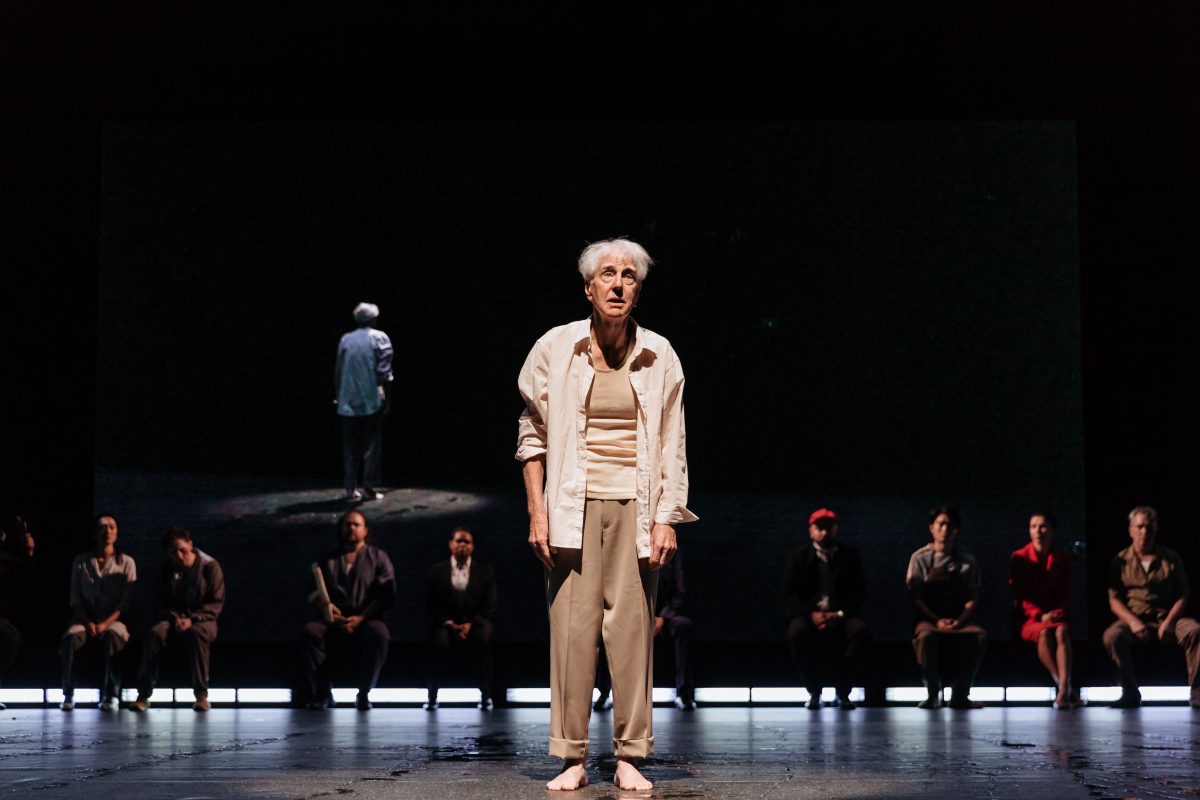
Peter Carroll and cast of The Resistable Rise of Arturo Ui, Sydney Theatre Company, photo © Daniel Boud
Throughout, Brecht’s rich language is inflected with familiar contemporary utterances: “with respect, you’re not listening,” Joe Hockey’s “leaners, not lifters,” Ui’s plagiarising of the lyrics of John Farnham’s “You’re the Voice,” and much more — “slush funds,” “positive mindsets,” and a green grocery variation on John Howard’s “We will decide who comes to this country and the circumstances under which they come.” And then there’s the fun of invention: “Even the gravy train finds itself stopping at honest stations.” The apparent silliness in the recurrence of the names of vegetables — cabbage, cauliflower, kohlrabi — in a political scenario gets continued laughs but also underlines the banality of corruption and an everyday route to power, and profit — think Coles and Woolworths’ relentless manipulation of what they pay dairy, fruit and vegetable producers.
Williams’ performers, often in multiple roles, create strongly etched characters including Ui’s gang members: Roma (Colin Moody), Giri (Ivan Donato) and Givola (Ursula Yovich). Stefan Gregory’s bracing compositions, with recurrent driving drumming and a film-noirish gravitas sound gives over to Wagner at a critical moment and a melancholy wordless chorale at another. An affecting harp piece underlines the apparent idyll of Givola’s florist shop in which Betty Dullfleet’s husband’s throat is cut by the owner. This setting is one of the few instances in the production where spectacle, multiple long strands of flowers luxuriously filling the stage, supersedes distanciation, if meeting the challenge of Brecht’s construction of the scene with two pairs of characters, oblivious to each other, wandering the shop. Another superfluity is the use of projected animated drawings — a row of poplars, a burning market building, a woman in a street. Elsewhere the production, including its deft use of intertitles, is tightly conceived and executed.
Ui’s chilling speech to the masses at the play’s end recalls Donald Trump’s dark account of the state of America in his inauguration speech. Ui spells out a vision of human savagery against which he will defend the people (dissidents are meanwhile casually shot) while offering them freedom of choice. Ui’s cool, formulaic manner recalls Betty Dullflet’s earlier defiant charge that Ui is “a meat machine trying to believe it has a self.” Now she stands beside him, defeated. The chaotic dance that prefigured Ui’s ascension is over, resolved into fascist order, overseen by a man who had declared to Betty, “I am a fanatic – I have faith.”
Our own liberal democracy is under less corrosive threat than that depicted in Brecht’s parable, and is therefore easy to underestimate or ignore, while in Turkey and the newer democracies of Eastern Europe human rights are rapidly eroding. It’s surprising and fascinating that an emerging wing of the American Democrats is the defiantly titled Democratic Socialists of America. In Australia’s parliament, we have proliferating right wing party representatives, a conservative often reactionary Coalition government and a Labor Party largely driven by its right wing. How long will it be before a defiant assertion of democratic socialism emerges in Australia to defend and build on public utilities and rights? Better that than a slow dance to death. But it is resistible.
–
Sydney Theatre Company, The Resistible Rise of Arturo Ui, writer Bertolt Brecht, translator Tom Wright, director Kip Williams, performers Mitchell Butel, Peter Carroll, Tony Cogin, Ivan Donato, Anita Hegh, Brent Hill, Colin Moody, Monica Sayers, Hugo Weaving, Charles Wu, Ursula Yovich, set designer Robert Cousins, costume designer Marg Horwell, lighting designer Nick Schlieper, composer, sound designer Stefan Gregory, cinematographer Justine Kerrigan; Roslyn Packer Theatre, Sydney, 21 March-28 April
Top image credit: Anita Hegh, Hugo Weaving, The Resistable Rise of Arturo Ui, Sydney Theatre Company, photo © Daniel Boud
A dauntingly large, acutely white picture frame proscenium looms steeply before the audience. Within, a radiantly sheened black velvet curtain; behind, a depthless darkness populated from time to time with barely moving ghostly figures. From within this pictorial framing of director Adena Jacobs and composer Damien Ricketson’s The Howling Girls emerges a wordless reverie-cum-nightmare theatre of image, vocal and electronic sound staged by Sydney Chamber Opera at its boldest, probing trauma symptomatology and “female hysteria,” channelling the mysterious suffering of five New York girls in the wake of 9/11.
In an enduring initial blackout I hear breathing like my own on a still night bereft of moon and stars. Though sonically wrapped around me, it’s not mine, this slow, slightly urgent inhalation, a click in the throat and then exhalation, regular and insistent and subsequently textured with a whispering whistle and the light slap of saliva. I’m in the dark, inside another’s head, while before me the breather (soprano Jane Sheldon) is slowly revealed, reclining in the deep distance in a thin sliver of light, her breathing now voiced, possibly faster, possibly anxious, with a soft rasp.
An intense white light appears across one end of her body and repeatedly tracks down its length, like an MRI scanner, suddenly literalising Sheldon’s character as suffering a condition under investigation, increasing the sense of anxiety. At the same time, repetitive vowel series slowly take shape, evolving into soft chant-like sequences from which eventually comes a surprising, full-bodied, sharp-edged ‘naaaahh’ and the beginnings of a haunting emergent musicality.
Intermittent, otherworldly rumblings and dark glissandi hauntingly punctuate and weave into the increasingly reverberant, amplified voice, intensifying the drama of its evolution from low, tense respiration into seemingly unconscious ritualistic invocation. On the other side of the stage stands a barely perceptible cluster of shadowy figures, forming a piercing chorus of young female voices extending in substantially long notes Sheldon’s urgent utterances. What commenced as a single state of individual being now assumes a larger if mysterious import in which others give empathetic voice to the woman’s condition and perhaps express their own.
Sheldon rises from her bed and moves forward onto the wide lower edge of the picture frame attired in a lightly furred, seemingly armless garment with a hint of straitjacket. Standing still, she is suddenly rendered breathless and voiceless, choking, gasping and coughing, raw, guttural and profoundly discomfiting for an interminable few minutes. The effort invested in trying to communicate in The Howling Girls’ first movement, Summoning, is devastatingly undone in this second one, Blockage. It simultaneously evokes the symptoms of the young women who inspired director Jacobs to make this work. In the wake of 9/11, five New Yorkers from different parts of the city and unknown to each other, but admitted to the same hospital, believed they had ingested flesh and debris from the explosions. They hadn’t. Their throats constricted, none could eat, seemingly suffering what once would have been labelled collective hysteria.
Emerging eerily from the dark, Jacobs’ howling girls are alien creatures, wrapped in long-stranded, shiny black fur, black hair flopping over faces, their hands clutching tiny skulls (Aztec death whistles), like a cult born of 9/11. Appearing to be naked beneath the fur, they are calm, neither overtly howling nor “hysterical,” but vocally mournful even though their presence is possibly playful, maybe dangerous. Whatever, they abet Sheldon in giving voice to trauma.
In the opera’s final scene, the girls appear in body stockings, simply themselves, constructing a language from scratch from seemingly random syllables in a collective, melodic warbling (bar some eerie, rhythmic stutterings), their choralling in sync with Sheldon, who in glorious melancholy voice (evoking multiple idioms and voice types) moves into the distance towards a thin vertical line of bright light and disappears. The title of this final movement, Broken Aria, suggests the defeat of an operatic “hysteric.” Even so she leaves us with a new generation who should no longer be clinically labelled. Amid their singing the girls play simple instruments evocative of communality and ritual while the overarching score utters frantic electronic signals and industrial growls, countering any too easy idealism.
In a scene prior to this conclusion, Sheldon vocalises wordlessly into a large, long megaphone-cum-finely styled horn, duetting sublimely with a theremin player, their faces unseen in a passage of calm but short-lived transcendence erased by a monumental sound and light drama. The picture frame is bathed in deep pinks and reds; the theremin glides and swoops, electronics thunder, voices scream and a massive crash leaves us quivering in silence. It’s as if a trauma (the soprano’s or the New York girls’ 9/11 experience) has been unwillingly revisited as a cathartic prelude to the final scene of loss and new generation.
With strictly limited movement and an intense focus on sound, each scene in The Howling Girls is abstractly pictorial. But light and its absence, the emergence of bodies from darkness and their disappearance into it, limited but stark colouration and effects like the tight lighting of instruments (a drum in one scene, a theremin in another) suggesting suspension in a dream space, coalesce into an engaging visual dynamic that courses from claustrophobia to shock, to the bright, warm openness of the opera’s final moments with the girls in a welcoming semi-circle before us.
Despite a high level of abstraction, The Howling Girls is a bracingly cogent work (though the significance of the megaphone-cum-horn eluded me) with an implicit narrative trajectory as indicated by the titles of the work’s movements, the literalness of the scanning light in the first, the direct referencing of New Yorkers’ trauma symptoms in the second and third, the vocal symbiosis between Sheldon and the girls, the return of the traumatic experience, and the final image of the passing of a lone Everywoman and the emergence of a new generation of women functioning collectively to create an incipient lyrical language of free-floating vowels and syllables.
The production’s focus on listening is richly rewarding. Jane Sheldon’s virtuosic performance in unchartered territory and Damien Ricketson’s meticulous, fluent scoring reveal the voice in all its staggering dimensions, ranging from its origins in breath, from high soprano to deep mezzo, from head to chest and edging into throat singing. Stress, bordering on hyperventilation, is rendered musical and contemplatively resolved. Jack Symonds’ theremin, keyboard and electronics and Bob Scott’s sound design sustain the material viscerality of the voice while simultaneously enlarging it on an orchestral scale that speaks of its magnificent expressivity. The synthesis of Eugyeene Teh’s set design and Jenny Hector’s lighting evokes a world at once rigidly restraining, nightmarishly depthless and expansively open to possibility. The Howling Girls is a memorable opera without words, sparely physically animated, pictorially and sonically immersive, a remarkable celebration of the voice and, with a utopian aura, a continuation of the feminist project to de-pathologise and give voice to the extremes of women’s experiences.
–
Carriageworks & Sydney Chamber Opera, The Howling Girls, composer Damien Ricketson, musical director Jack Symonds, director Adena Jacobs, set & costume design Eugyeene Teh, lighting design Jenny Hector, sound design Bob Scott, performers Jane Sheldon with members of The House that Dan Built: Grace Campbell, Kittu Hoyne, Kiri Jenssen, Emily Pincock, Jayden Selvakumaraswamy, Sylvie Woodhouse; Carriageworks, Sydney, 28 March-7 April
Top image credit: Jane Sheldon, The Howling Girls, Sydney Chamber Opera, photo Zan Wimberley
Happy May Day — International Workers’ Day! And welcome to our 2018 series of occasional reviews and, soon, copious surprising highlights from and reflections on 24 years of RealTime publishing, culminating later in the year in a number of open forums. We and our writers will be assaying what happened in the arts in Australia over the last quarter of a century, registering huge shifts in ideas, forms and engagement with audiences, science and new technological tools. To be able to look back in a society so preoccupied with the present is an all too rare opportunity to gauge in a considered way just what comprises ‘now’ and what might come next. We hope our reflections will encourage your own and that you’ll share them with us. Soon we’ll be posting searchable PDFs of the first 40 editions of RealTime, 1994-2000, on our website, providing an opportunity to browse a period of remarkable cultural ferment. In the meantime, in the first of our occasional reviews we applaud Sydney Theatre Company’s The Resistible Rise of Arturo Ui, Sydney Chamber Opera’s The Howling Girls and Readymade Works’ Happy Hour. Keith & Virginia
–
Image credit: Colin Moody, Hugo Weaving, The Resistable Rise of Arturo Ui, Sydney Theatre Company, photo © Daniel Boud


